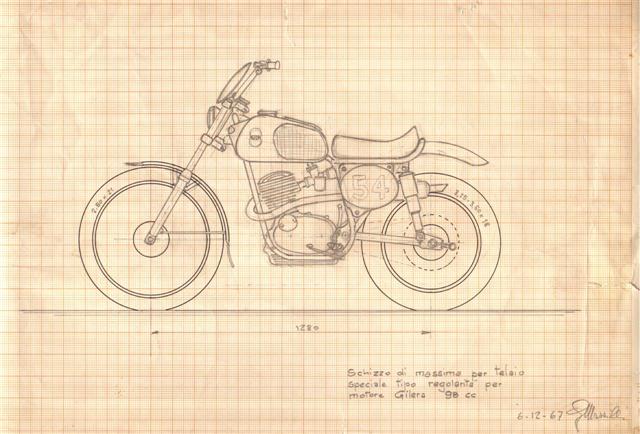


Durante la prima fase della carriera di pilota, Giorgio Mazzilli usò le migliori moto da regolarità allora presenti sul mercato (Gilera, Capriolo, Laverda, ecc), ricavandone una particolare impressione.
Quello che al pilota Giorgio non piaceva troppo derivava dal fatto che quasi tutte le moto in uso sui campi da gara erano parenti troppo stretti dei modelli stradali.
La conseguenza era quindi un assetto di guida, ed un telaio, non in sintonia con l’uso specifico richiesto dalla tipologia di gara.
Incominciò, nella testa di Giorgio, a farsi strada l’idea di costruire da sè la moto che potesse soddisfare completamente le proprie e magari le altrui esigenze.
Il lavoro portò il futuro costruttore per qualche anno in giro per il mondo a disegnare e realizzare complicati impianti industriali per conto di compagnie del settore, distogliendolo, di fatto, dal progetto motociclistico.
Verso la fine degli anni 60, tornato a casa dal lungo viaggiare, riprese le gare di regolarità incontrando ancora gli stessi problemi che lo avevano assillato prima dello stop imposto dalla sua prestigiosa attività.
Fu la molla definitiva che portò Giorgio Mazzilli a sedersi al tecnigrafo e ad iniziare lo studio e la progettazione della moto da lui ritenuta ideale.
Siamo nel Gennaio 1969, quando dalla matita di Giorgio scaturisce il prototipo equipaggiato dal motore Maico in configurazione cross. Lo studio del telaio è in ogni caso finalizzato alla costruzione di una piccola serie di moto da regolarità.
Nel Novembre dello stesso anno inizia la reale progettazione del modello da regolarità dotato del motore tedesco Sachs 125cc a 5 marce.
Sono datati inizi dell’anno 1970 i primi 5 esemplari con motori Sachs di 100 e 125cc destinati a lui stesso e ad amici-piloti (Toso, Picozzi, Galli).
Alberto Riva
Maurizio Boscariol
During the first phase of his career as a rider, Giorgio Mazzilli used the best regularity motorcycles then on the market, with Gilera, Capriolo, and Laverda making a strong impression on him.
What Giorgio did not like was that almost all the machiness in use in the racing sectors were too closely related to the road models.
The consequence was therefore that neither the engine nor the chassis were in tune with the specific use required for the type of racing.
The idea of building his own motorcycle that could completely satisfy his own and perhaps the needs of others began to take root in Giorgio's head.
The work took the future manufacturer around the world for a few years to design and build complicated industrial systems on behalf of companies in the sector, effectively distracting him from the motorcycle project.
Towards the end of the 60s, having returned home from his extensive travels, he resumed regularity racing, still encountering the same problems that had tormented him before the stop imposed by his prestigious activity.
It was the definitive trigger that led Giorgio Mazzilli to sit down at the drawing board and begin the study and design of the motorbike he considered ideal.
In January 1969 Giorgio drew the prototype equipped with the Maico engine in motocross configuration. The study of the frame is the first step towards building a small series of regularity motorcycles.
In November of that year the final design of the regularity model began, equipped with a Sachs 125cc 5-speed engine.
The first five examples, fitted with 100 and 125cc Sachs engines and built for himself and his friends Toso, Picozzi and Galli, appeared early in 1970.
In the same year, given the excellent results obtained in competition, Mazzilli created his first series, building around 90 similar motorcycles which highlighted the excellent balance of the chassis and a centered riding posture, which did not fail to arouse great curiosity among those looking for a machine to tackle tough regularity races.
But a self-respecting designer will always try to improve, so in 1972, sitting down again at the drawing board, a second series appears (the one with the filter on the tank) developed with considerable experimentation and with the fundamental contribution of two intermediate prototypes . The creation of 100 examples and the participation in the XXIV Valli Bergamasche will support, without fear of contradiction, the thesis of the quality of the product.
During 1974, a period permeated by profound socio-cultural revolutions, the manufacturer was stimulated to design a new livery well in tune with the historical moment. The lines become soft and rounded, the saddle-tank connection is continuous, the general style of the motorcycle is more avant-garde. Another 100 examples will project the third series into national and international races.
Giorgio Mazzilli rightly believed that a model of this magnitude would not need a drastic change, but only refinement to better enhance its characteristics. In 1975 came the appearance of the fourth series which, thanks to a particular muffler, will be remembered with the nickname "TUBONE"; the 90 motorbikes built will be considered by critics as the final sum of Mazzilli's intervention skills on mechanics and chassis.
Times change, and even regularity bikes unfortunately have to adapt to various fashions. The aluminum tank, the headlight holder and the American Preston mudguards of the fifth series testify to this. With the 50 motorcycles built from late 1975 into 1976, Giorgio Mazzilli wrote the final word to this wonderful adventure which involved hundreds of enthusiasts, becoming one of the greatest icons of the off-road world, and adding, with the creation of the quite wonderful exhaust system, its own musical signature.
Alberto Riva
Maurizio Boscariol